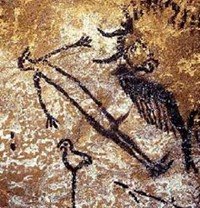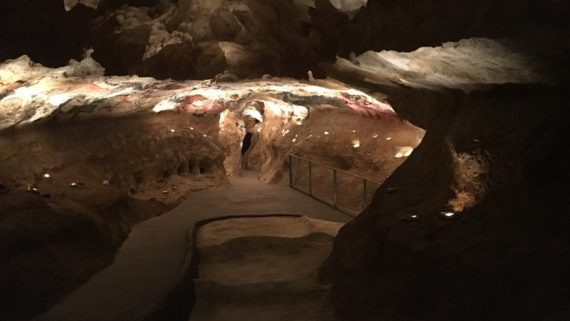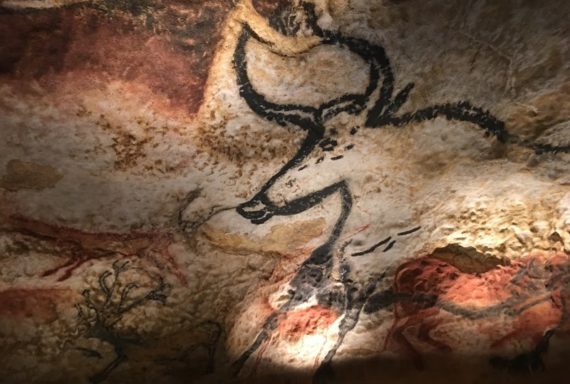Lascaux Cave Paintings.
Lasceaux is in the Dordogne region in southwest France. In 1940 a teenager named Marcel Ravidat, hunting for a lost dog with three friends, discovered a shaft into a cave system that had been inhabited nearly 20,000 years previously by pre-historic artists. The caves contain 364 identifiable paintings of horses, 90 paintings of stags, plus cattle and bison, 7 felines, a bird, a bear, a rhinoceros, and a dead human.

A painting of a dead human from the caves at Lasceaux.
The paintings were created in the late Solutrean Era and early Magdalenian period [c.20,000-13,000BCE]. At that time pre-historic man existed as a hunter-gatherer living off herds of reindeer on the continental tundra just outside of the retreating ice pack.

Painting from Lasceaux
Things were different in those days. Ice Age artists had to make their own paint.
So…
“How Did Prehistoric Painters Obtain Their Colours?
Stone Age artists relied on several different types of material to make the colour for their painting. Clay ochre was the main pigment and provided three basic colours: yellow, brown and numerous hues of red. For black pigment, artists typically employed either manganese dioxide or charcoal, or burnt bones (known as bone black). For white pigment, they used kaolin or ground calcite (lime white). These colourants were first ground up to powder (using animal shoulder bones as mortars), then mixed with cave water (high in calcium carbonate) vegetable juice, animal fats, blood, bone marrow, albumen, and urine to help it adhere to the cave wall. In addition, they used extenders like feldspar and biotite, or ground quartz and calcium phosphate (from crushed animal bone), in order to save on the pigment, to make the paint adhere more firmly to the cave wall and to prevent the paint from cracking when drying.
Where Did Prehistoric Artists Get Their Pigments from?
Nearly all paint pigments used in caves were sourced locally. Where clusters of caves existed, such as in the Dordogne region of southwest France, the occupying artists would have used the same mines for their pigments. And as Stone Age painters discovered that pigments from earthy iron oxide deposits did not fade as fast as colours derived from animal and vegetable sources, they went to great effort to locate a good supply of these dyes: the majority of prehistoric settlements show signs of well-used trails leading to hematite mines or digs where such pigments were obtained. For example, excavations in the vicinity of the Lascaux Cave complex suggest that Paleolithic artists may have travelled as far as 25 miles for a reliable source of pigments.”

Inside the caves at Lasceaux.
But there is a major problem.
The tragedy is that after lasting thousands of years, in the few decades since the discovery of Lasceaux, the paintings have suffered extensive deterioration. Lichens and crystals began to appear on the walls in the late 1950s, leading to closure of the caves in 1963. The cause is a fungus or mould that was initially introduced by thousands of visitors during the two post war decades of public viewing. The caves have been sealed shut since 1963 in an attempt to contain the damaging organisms.
It gets worse.
In 2001, the authorities in charge of Lascaux changed the air conditioning system which was regulating the temperature and humidity. After the later system was installed, an infestation of a white mould began spreading rapidly across the cave ceiling and walls. The mould is considered to have been present in the cave soil and exposed by the work of tradesmen, leading to the spread of the fungus which was treated with quicklime. In 2007, a new fungus, which has created grey and black blemishes, began spreading in the real cave.

Lasceaux cave painting.
The collection of paintings is now seriously threatened.
The French authorities and international scientific and artistic communities are very concerned and a symposium is trying to solve the problem.
Lascaux Cave Paintings Symposium
“…Rock art as a whole is one of the most important cultural heritage assets in the history of Humanity. Lascaux is certainly one of its jewels, but the most humble of the decorated sites is a witness of ancient cultural beliefs and practices, and therefore it must be protected. Lascaux strongly reminds us of the reasons why preservation is a necessity: above all to limit the effects of human activity on any decorated sites, and on their surrounding environment. “
Jean CLOTTES
President of the Symposium
Now the French government has spent $64 million building a near perfect replica to recreate the original cave.
Fortunately we do have extensive photographic records, and the three dimensional facsimile visitor attraction has been created nearby. It is accurate down to three millimetres thanks to 3D digital scanning of the actual cave. Every nook and cranny is recreated using the latest polystyrene, resin, and fiberglass techniques.
Thanks for quotes and other information from Wikipedia and The Bradshaw Foundation




